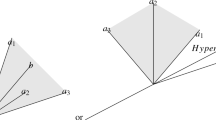Conclusion
A well-known parable from crime stories: Once the balance of the Bank of England was off by three pence. Trying to find the mistake, one of the greatest embezzlements in history was discovered. The attempt to correct the bad behavior of the Simplex Method for a very few artificially constructed examples may have led to a major breakthrough in combinatorial optimization.
Similar content being viewed by others
References
C. Berge (1958). Sur le couplage maximum ďun graphe.C. R. Acad. Sci. 247, 258–259.
C. Berge (1973).Graphs and hypergraphs. North-Holland.
G. B. Dantzig (1951). Maximization of a linear function of variables subject to linear inequalities, in: T. C. Koopmans, ed.:Activity Analysis of Production and Allocation. New York: Wiley, p. 339–347.
J. Edmonds (1965). Paths, trees and flowers.Canad. J. Math. 17, 449–467.
J. Edmonds (1965). Maximum matching and a polyhedron with 0, 1-vertices.J. Res. Nat. Bur. Stand. B1-2, 125–130.
J. Farkas (1902). Über die Theorie der einfachen Ungleichungen.J. Reine Angew. Math. 124, 1–24.
D. B. Judin and A. S. Nemirovskii (1976). Informational complexity and effective methods for the solution of convex extremal problems (Russian), Ekon. i Maternat. Metody 12 (No 2) 357–369.
L. V. Kantorovich (1939).Mathematical Methods in the Organization and Planning of Production. Publ. House Leningrad State Univ.
L. G. Khachiyan (1979). A polynomial algorithm for linear programming.Dokl. Akad. Nauk SSSR 244, 1,093–1,096. Translated inSov. Math. Dokl. 20, 191–194.
V. Klee — G. Minty (1972). How good is simplex algorithm? in: O. Shisha, ed.:Inequalities III. New York: Academic Press p. 159–175.
L. Lovász (1979). On the Shannon capacity of a graph.IEEE Trans. Inf. Th. IT-25, 1–7.
G. L. Miller (1976). Riemann’s hypothesis and tests for primality.J. Comput. System Sci. 13, 300–317.
J. von Neumann (1947). On a maximization problem, (manuscript), Institute for Advanced Study, Princeton.
N. Z. Shor (1969). Convergence rate of the gradient descent method with dilation of the space.Kibernetika 2, 80–85.
W. T. Tutte (1947). The factorization of linear graphs.J. London Math. Soc. 22, 107–111.
Author information
Authors and Affiliations
Rights and permissions
About this article
Cite this article
Lovász, L. A new linear programming algorithm — better or worse than the Simplex Method?. The Mathematical Intelligencer 2, 141–146 (1980). https://doi.org/10.1007/BF03023055
Issue Date:
DOI: https://doi.org/10.1007/BF03023055




